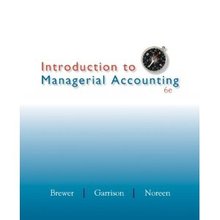Instant download Introduction to Managerial Accounting Brewer 6th Edition Test Bank pdf docx epub after payment.

Product details:
- ISBN-10 : 1260060411
- ISBN-13 : 978-1260060416
- Author: Suresh Kalagnanam; Eric W. Noreen
The 6th Canadian Edition continues to build on previous editions with a strong focus on problem material providing students with more opportunities to practice and master key accounting concepts. Updated real-world examples are integrated through-out the text making accounting even more relevant to today’s students.
Table Of Contents:
- Chapter 1 An Introduction to Managerial Accounting
- The Management Cycle and the Need for Managerial Accounting Information
- Strategy
- Planning
- Implementation
- Control
- Financial and Managerial Accounting
- For the Managers
- Emphasis on the Future
- Relevance and Flexibility of Data
- Emphasis on Timeliness
- Focus on Segments of an Organization
- Regulation
- Managerial Accounting—Not Mandatory
- Are Financial and Managerial Accounting Independent?
- Increased Relevance of Managerial Accounting
- Globalization
- The Lean Business Model
- Just-in-Time
- The JIT Approach
- Zero Defects and JIT
- Total Quality Management
- The Plan–Do–Check–Act Cycle
- Process Reengineering
- The Theory of Constraints
- An Example of TOC
- TOC and Continuous Improvement
- Ethical Responsibility and Corporate Governance
- Professional Ethics
- Corporate Governance
- Implications of the Changing Business Environment on Managerial Accounting
- Organization of the Text
- Learning Objectives Summary
- Questions
- Exercises
- Problems
- Appendix 1A: Code of Ethics for Professional Accountants—International Federation of Accountants
- PART I: PRODUCT AND SERVICE COSTING
- Chapter 2 Cost Concepts
- Why Cost Classification Is Important to Managers
- Cost Classification by Behaviour
- Variable Cost
- Fixed Cost
- Cost Classification by Traceability
- Direct Cost
- Indirect Cost
- Cost Classification by Relevance
- Differential Cost and Revenue
- Opportunity Cost
- Sunk Cost
- Cost Classification by Function
- Manufacturing Costs
- Nonmanufacturing Costs
- Product Costs Versus Period Costs
- Product Costs
- Period Costs
- Cost Classifications on Financial Statements
- The Balance Sheet
- The Income Statement
- Schedule of Cost of Goods Manufactured
- Product Costs—A Closer Look
- An Example of Cost Flows
- Cost Classification Summary
- Learning Objectives Summary
- Application Competency Summary
- Review Problem 1: Cost Terms
- Review Problem 2: Schedule of Cost of Goods Manufactured and Income Statement
- Questions
- The Foundational 15
- Brief Exercises
- Exercises
- Problems
- Building Your Skills
- Chapter 3 Systems Design: Job-Order Costing
- The Purpose of Costing Systems
- Types of Costing Systems
- Job Shops and Job-Order Costing
- Flow Shops and Process Costing
- Approaches to Costing—Key Management Decisions
- Absorption Versus Variable Costing Approaches
- Normal Versus Actual Costing Approaches
- Overhead Cost Allocation Approaches
- An Overview of Job-Order Costing—Determining the Cost of a Specific Job
- Measuring Direct Materials Cost
- Job Cost Sheet
- Measuring Direct Labour Cost
- Application of Overhead
- Choice of an Allocation Base for Overhead Cost
- Computation of Job Costs
- Cost Flows in a Job-Order System
- The Purchase and Issue of Materials
- Labour Cost
- Manufacturing Overhead Costs
- Cost of Goods Manufactured
- Cost of Goods Sold
- Summary of Manufacturing Cost Flows
- Under- and Overapplied Overheads
- Causes of Under- and Overapplied Overheads
- Disposition of Under- or Overapplied Overhead Balances
- Multiple Predetermined Overhead Rates
- Nonmanufacturing Costs
- Learning Objectives Summary
- Application Competency Summary
- Review Problem: Job-Order Costing
- Questions
- The Foundational 15
- Brief Exercises
- Exercises
- Problems
People also search:
Introduction to Managerial Accounting
Introduction to Managerial Accounting Brewer Garrison Noreen
Introduction to Managerial Accounting Brewer Garrison Noreen 6th
Introduction to Managerial Accounting Brewer Garrison Noreen 6th Test Bank
Introduction to Managerial Accounting Brewer 6th Edition Test Bank





